Featured image credit: Austin Desisto for Everyday Astronaut
United Launch Alliance (ULA) finally launched its new Vulcan rocket for the first time on Monday, Jan. 8, 2024, at 07:18 UTC. Vulcan is the first vehicle that ULA has developed from scratch and is likely the company’s last chance to survive in the modern spaceflight boom.
Comparison To The Competition
First, the size of these vehicles will be compared. The Atlas V is up to 58.3 meters tall (depending on fairing configuration) with the core being 3.8 meters wide. The Delta IV Heavy is 72 meters tall, with each side core being five meters wide. Vulcan is significantly wider at 5.4 meters and 61.2 meters tall.
Falcon 9 and Falcon Heavy share the same 3.7-meter cores and stand up to 70 meters tall.
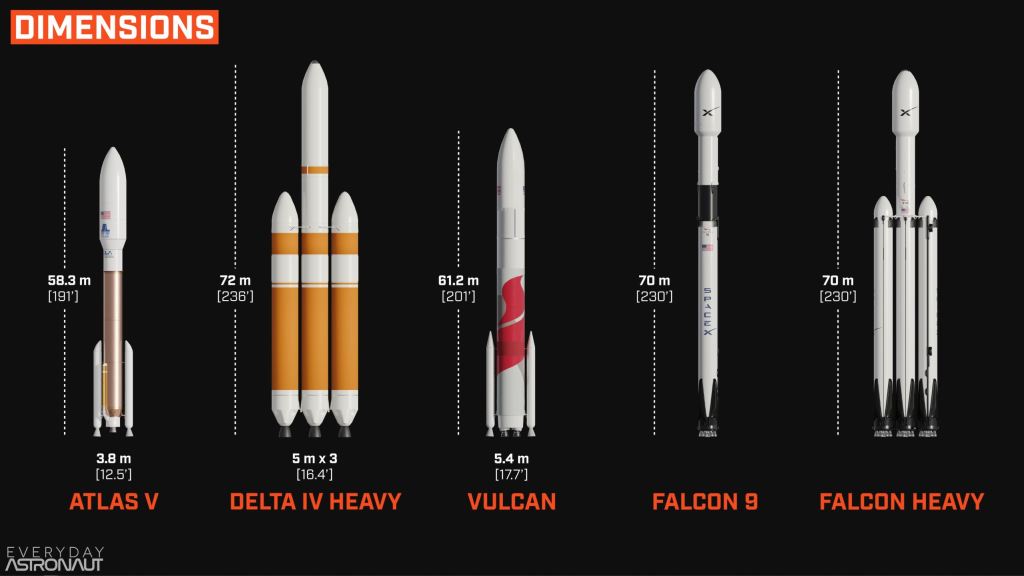
Next, we’ll compare the engines on each of these vehicles. To better understand the engine cycles below, check out Everyday Astronaut’s explanation.
The Atlas V boasts a single oxygen-rich closed cycle RD-180 engine, fueled by Kerolox — a combination of liquid oxygen and RP-1 or kerosene. Generating 3.83 MN of thrust at sea level and achieving specific impulses of 311 seconds (at sea level) and 338 seconds (in a vacuum), the RD-180 is a powerhouse. However, geopolitical constraints have led to the unavailability of the ULA to sanctions against Russia post the 2014 Ukraine conflict, contributing to Atlas V’s eventual retirement.
The Delta IV Heavy features the open cycle dual gas generator RS-68A engine, which relies on liquid hydrogen and liquid oxygen (hydrolox). These engines produce 9.3 MN of thrust between all three and each engine archives a specific impulse of 360 seconds (at sea level) and 412 seconds (in a vacuum).
Vulcan is powered by two Blue Origin-built BE-4 engines utilizing liquid methane and liquid oxygen (methalox). With a combined thrust of 4.9 MN for the core stage, Vulcan promises enhanced performance. The addition of up to six GEM 63 XL solid rocket boosters further catapults Vulcan’s lift-off thrust to a staggering 18.1 MN, surpassing its predecessors.
SpaceX’s Falcon 9 and Falcon Heavy rely on Merlin 1D engines in an open-cycle gas generator configuration. The Falcon 9 produces 7.6 MN of thrust, while the Falcon Heavy triples that with a remarkable 22.8 MN. Despite its lower thrust without solid rocket boosters, Vulcan comes close to Falcon Heavy’s might when equipped with six SRBs.

The Atlas V’s Centaur upper stage is equipped with one or two RL-10 engines, in the expander cycle. These engines operate on hydrolox and produce up to 102 kN of thrust each with an impressive specific impulse of 450 seconds. This stage serves as the powerhouse responsible for injecting payloads into their precise orbits.
The Delta Cryogenic Second Stage (DCSS) of the Delta IV Heavy relies on a variant of the RL-10, the RL-10B-2. In a vacuum, this engine produces 110 kN of thrust and attains an extraordinary specific impulse of 465 seconds. Similarly, Vulcan uses the Centaur V second stage: a stage with two RL-10C engines that also run on hydrolox and produce 106 kN of thrust each and get 454 seconds of specific impulse in space. Vulcan’s upper stage eventually should get the RL10C-X which would achieve 461 seconds of specific impulse.
In the future, ULA might offer a long-duration boil-off prevention with the integrated vehicle fluids system which could allow an on-orbit life span of weeks instead of hours. Additionally, a LEO-optimized version with shorter tankage to lower costs may happen in the future, too.
On the other hand, the Falcon upper stage uses a single vacuum-optimized Merlin 1D engine, which is still an open-cycle gas generator engine that produces 981 kN of thrust. Due to being open cycle and burning keroalox, the specific impulse is significantly lower than the Centaur second stage at only 348 seconds.
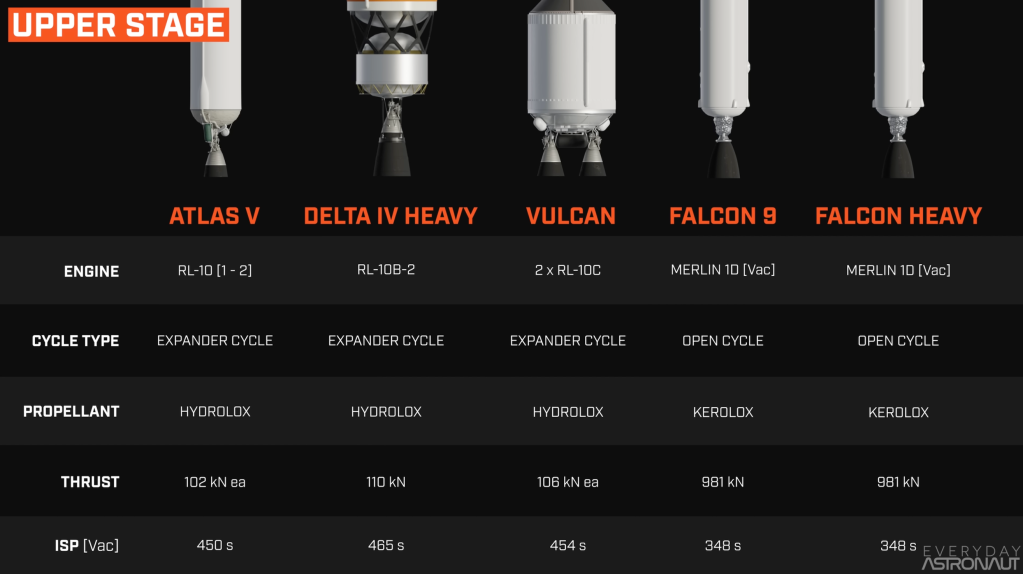
The Atlas V, in its various configurations, showcases versatility in payload capacity. Its payload to low-Earth orbit (LEO) ranges from 9.8 tonnes in its basic form to a formidable 18.8 tonnes in the most powerful Atlas V 551 configuration. For geostationary transfer orbits (GTO), the Atlas V can deliver payloads ranging from 4.7 tonnes to 8.9 tonnes, contingent upon the specific configuration chosen. The Atlas V’s adaptability allows it to cater to a spectrum of mission requirements.
As the heavy in Delta IV Heavy implies, the vehicle boasts a payload capacity of 28.3 tonnes to LEO and 14.2 tonnes on a GTO. Its robust capabilities make it an ideal choice for missions requiring substantial payload delivery to both low and high-energy orbits.
ULA’s Vulcan emerges as the apex performer in payload capacity, offering an extensive range from 10.8 tonnes to 27.2 tonnes to LEO. When it comes to GTO missions, Vulcan excels, with the capacity to launch payloads ranging from 3.5 tonnes to 15.3 tonnes. This marks a significant leap forward, making Vulcan the most capable rocket ULA has ever built for high-energy orbits.
The comparison with SpaceX’s Falcon 9 and Falcon Heavy introduces an element of complexity due to Falcon’s reusability. The Falcon 9, when recovered, can lift around 18 tonnes to LEO. In contrast, when expended, its capacity increases to about 25 tonnes. Falcon Heavy, with reused side boosters and an expended center core, can launch between 30 and 40 tonnes to LEO. However, when fully expended, it can reach an impressive 64 tonnes to LEO.
While the Falcon rockets excel in LEO, their performance takes a hit in GTO due to the less efficient Merlin 1D engines compared to the high-performance RL-10 hydrolox engines used by ULA. Falcon 9, when recovered on an ASDS, can transport about 7 tonnes to GTO, expanding to closer to 8.56 tonnes when expended. When recovered back on land, Falcon 9 can place 1.8 tonnes into GTO. Falcon Heavy, with recovered side cores, achieves roughly 15 tonnes to GTO, contrasting with 26.7 tonnes when fully expended.
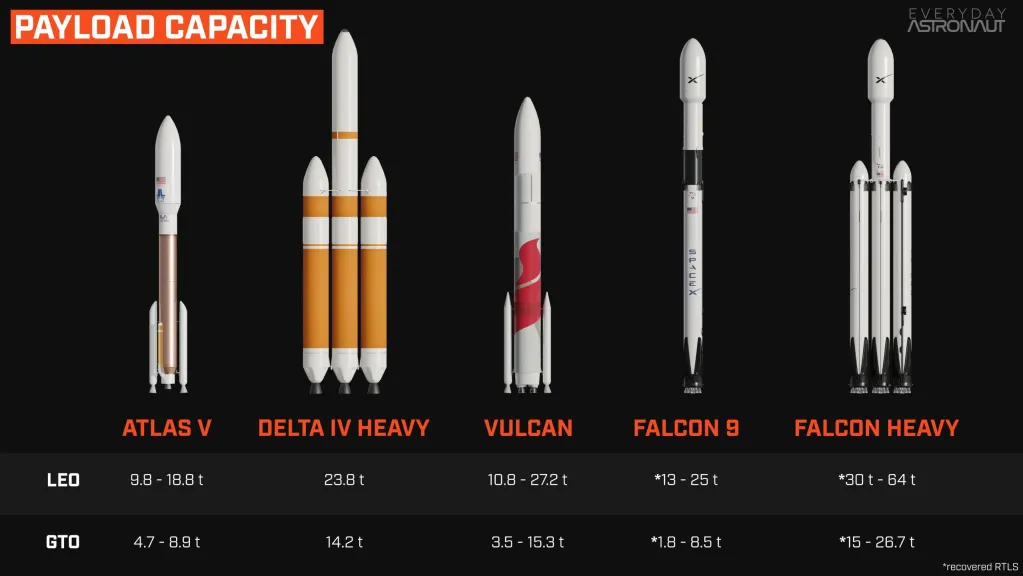
Finally, Atlas V and Delta IV both cap out at roughly 233 cubic meters of payload volume. Vulcan, on the other hand, maxes out at 310 cubic meters. This is substantially higher than Falcon’s current 145 cubic meter fairing; however, in the future SpaceX plans to offer an extended fairing option, which would max out at around 200 cubic meters.
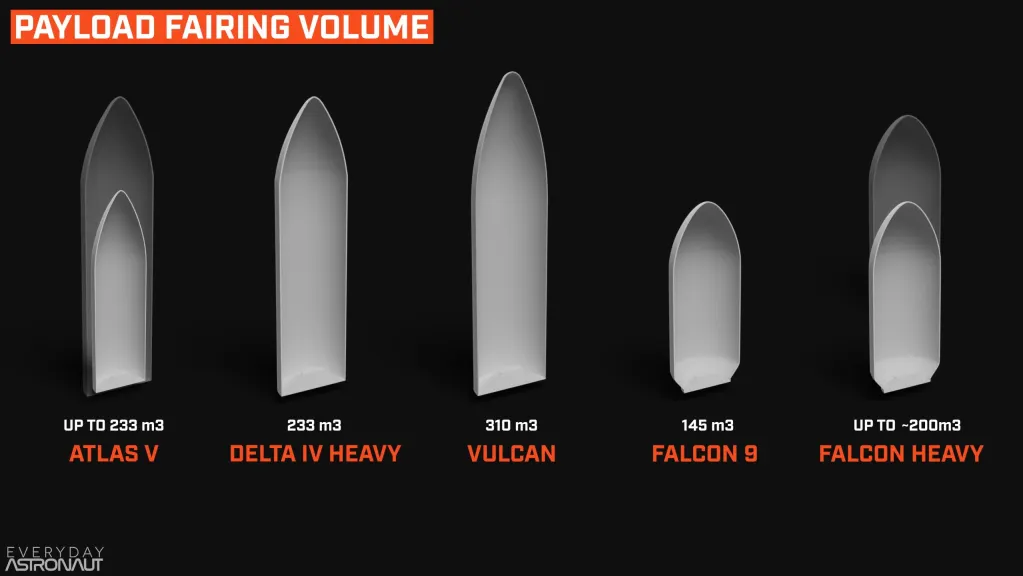
Finally, the cost of these launch vehicles will be compared. However, first, we must acknowledge the inherent complexities and the challenges of obtaining accurate and transparent information. One key differentiator in evaluating costs is recognizing the distinction between the price charged by companies and the actual cost incurred in launching rockets, with SpaceX’s emphasis on reusability potentially influencing profit margins.
Starting with ULA’s Atlas V, its base cost is approximately $109 million. However, detailed information on the cost variation between the standard model and the larger 551 variant is scarce. By factoring in the additional expense of GEM 63 boosters, each priced at $5 million, coupled with a more substantial and costly payload fairing, a reasonable estimate places the overall cost at around $150 million.
The Delta IV Heavy carries a price tag of approximately $300 million, making it one of the more expensive options available for launch services. This is one of the reasons why ULA is retiring the vehicle, as it only has one more launch left.
Vulcan is once again complex and reported to cost around $120 million per launch, and real-life data supports this claim. A Space Force contract awarded ULA $1.3 billion for 11 launches, averaging at $118 million per launch. Although SpaceX secured a 10-launch deal worth $1.23 billion, translating to an average of $123 million per launch. However, determining the cost of Falcon 9 and Falcon Heavy is difficult from this number, as this contract includes launches on both vehicles.
Notably, the Falcon 9’s commercial launch cost is estimated at $67 million, while Falcon Heavy commands around $100 million for commercial launches.
It is essential to consider the context of government contracts, which generally incur higher costs due to additional requirements. Despite this, ULA may have had to adjust its pricing to remain competitive, while SpaceX seems positioned to garner healthy profits from Space Force contracts.

Summary
While speculation about ULA and the Vulcan rocket is premature, certain facts and considerations offer insight into its current standing and potential challenges. Vulcan has a roster of around 70 launches: 20 launches for the US Space Force, 38 launches for Amazon’s Kuiper satellite constellation, and six missions for Dreamchaser.
ULA strategically designed Vulcan to cater to high-energy missions from the Department of Defense, a decision that has proven successful in securing National Security Space Launch contracts. However, as we evaluate its future, questions arise about whether Vulcan, being a mass-produced expendable vehicle, represents one of the last of its kind in the United States.
The concept of SMART reuse is part of ULA’s plans for Vulcan’s future. This involves recovering engines by detaching them from the booster, inflating a hypersonic heat shield, and then splashing down. While the recovery of the full booster is deemed impractical due to the velocity achieved at stage separation, ULA has conducted tests on a hypersonic inflatable reentry heat shield from orbital velocities, intended for use with Vulcan’s BE-4 engines. The implementation timeline, however, remains uncertain.
Despite being a traditional rocket in many respects, Vulcan has managed to establish itself as a capable and price-competitive vehicle. Interestingly, ULA’s approach has not exerted significant pressure on SpaceX to lower its costs. It appears that SpaceX is adjusting its prices to align with ULA’s offerings.
In the context of an evolving space industry with new entrants emphasizing reusability, such as Rocket Lab’s Neutron, Blue Origin’s New Glenn, and fully reusable rockets like Stoke Space’s and SpaceX’s Starship, questions about Vulcan’s longevity surface. While Vulcan addresses ULA’s needs by replacing both the Atlas V and the costly Delta IV Heavy with a single, more cost-effective rocket, its straightforward design took about five years longer than expected to reach its first launch.
Excitement surrounds the debut of any new rocket, particularly one utilizing Methalox, but Vulcan’s future might be constrained. As competition intensifies, with the potential for SpaceX to lower prices in response, Vulcan could face challenges in remaining cost-competitive. The coming years may usher in serious competition that puts pressure on SpaceX’s pricing, potentially impacting Vulcan’s viability. Until then, we witness the possibility of an era’s conclusion, observing the launch of massive, expensive rockets — a spectacle that may be replaced by more economically efficient alternatives in the aerospace industry.




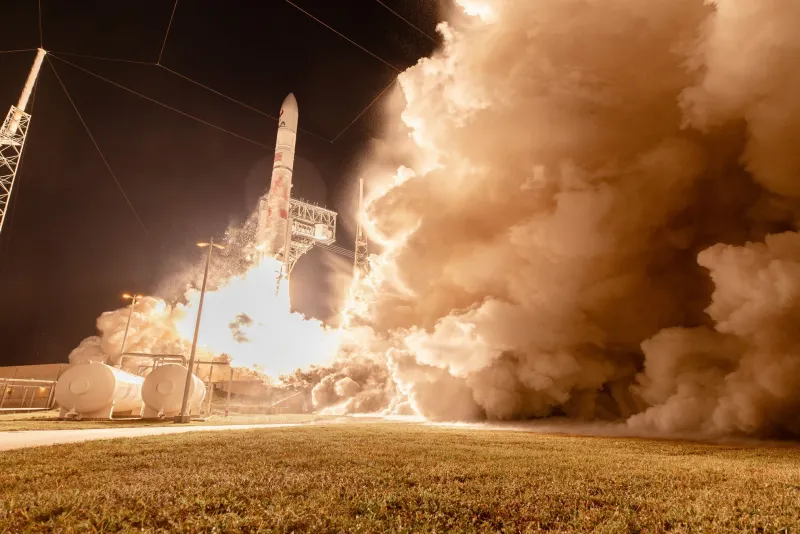
The article reads: The Delta IV Heavy features the open cycle dual gas generator RS-68A engine, which relies on liquid hydrogen and liquid oxygen (hydrolox). These engines produce 9.3 MN of thrust between all three and each engine archives a specific impulse of 360 seconds (at sea level) and 412 seconds (in a vacuum).
The word “archives” should be “achieves.” Also, if you fix this, by all means delete the comment, which will be uninteresting.